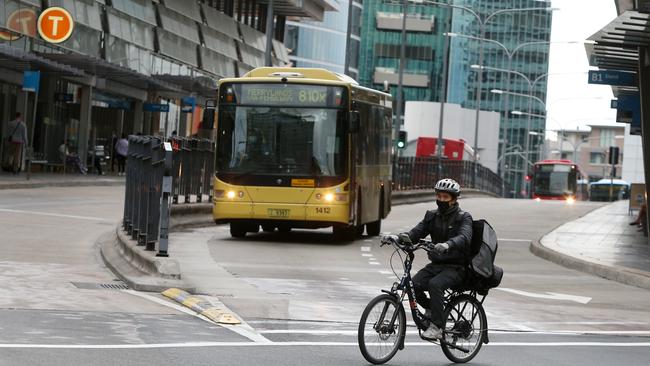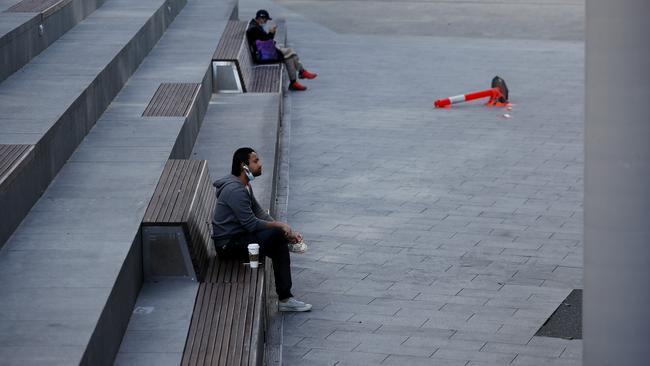Latest lockdowns could cost economy $20bn
The cost of the current round of Covid lockdowns could blow out to $20bn, economists have warned.

The cost of the current round of Covid lockdowns could blow out to $20bn, economists have warned, as they slashed their forecasts again in response to the latest four-week extension of the Sydney lockdown.
While a “JobKeeper2” fiscal stimulus was an “upside risk”, the current fiscal measures approaching $10bn would only support rather than boost household income, and a likely slower re-opening “probably moderates the rebound”, according to UBS chief economist George Tharenou.
“However, given recent lockdowns, and the risk of future lockdowns amid the Delta variant of Covid, there is a material increase in economic uncertainty,” he said.
In Mr Tharenou’s view the current lockdown will hit the economy by at least $20bn, more than twice as much as recent estimates by economists of an $8bn-$10bn impact from recent lockdowns in NSW and Victoria.
His comments came as shares pulled back from record levels with the prospect of a longer lockdown weighing on the market. The S&P/ASX 200 index closed down 0.7 per cent at 7379.3 points.
This could weigh of ASX-listed companies heading into August profit reporting season, with some likely to pull earnings guidance or pause planned dividend increases to keep balance sheets strong, he said.
Mr Tharenou also warned that the cost pressures and capacity constraints faced by business in the past financial year were set to continue, with labour shortages likely to “deteriorate further while international borders remain closed” and that this was increasingly likely until at least mid-2022.
But he noted that many businesses had been able to pass on rising costs by increasing their selling prices, with survey measures of such price increases around a record high.
“Lockdowns tend to see larger companies with flexible supply chains and online presence grab market share,” Mr Tharenou added.
AMP chief economist Shane Oliver said that, with the NSW lockdown extending through August, albeit with a partial reopening of the construction industry, the total direct cost of the lockdowns since the end of May was likely to be about $14bn, with less time for a quarter-end rebound.

“Even though other states are likely to keep growing – helped by the ending of the Victorian and South Australian lockdowns – GDP growth could now contract by around 2 per cent or so in the current quarter,” Dr Oliver said.
“That said, providing the lockdown ends this quarter we should see a strong rebound in the economy in the December quarter.”
CBA’s head of Australian economics, Gareth Aird, saw a “deep contraction” of 2.7 per cent in the September quarter. While expecting a 1.9 per cent rebound in the December quarter, he said the economy was now unlikely to surpass its June 2020 quarter peak until the March quarter of 2022.
In the absence of another JobKeeper-style program, he said the contraction in employment would be larger for Greater Sydney than it was in April-May 2020 when 20,000 jobs were lost.
“Given the lockdown will go for longer than the lockdown last year, we forecast employment to contract by about 300,000 in NSW,” Mr Aird said.
But because most workers stood down in NSW would “drop out of the labour force” because there would simply be no jobs available for most of them, the participation rate would fall and the measured rise in unemployment would be much less than the fall in employment.
On his calculations, the unemployment will peak at 5.6 per cent in October, before an improvement in the jobs market late this year that should lower the unemployment rate at 5.2 per cent.
“Substantial policy support will once again be needed to ensure that the economic rebound is swift when restrictions are eased,” Mr Aird said.
“The recently announced fiscal support is significant, but we suspect that policymakers will once again err on the side of doing too much rather than not enough and further stimulus is likely.”
Mr Aird’s modelling showed it would take until at least late October before 80 per cent of the adult population was vaccinated, “leading to significant restrictions for Greater Sydney until mid-fourth quarter”.
“Whilst this seems like a worst-case scenario, it is now our base case given the higher transmission rate of the Delta strain,” he said.
With his modelling suggesting daily Covid-19 cases active in the community in NSW would not reach zero for an extended period, he said Covid restrictions on Greater Sydney were only likely to be partially lifted until a vaccine threshold – assumed to be set at 80 per cent – had been reached.
And while assuming other states did not go back into lockdown, he expected lingering restrictions in Victoria to weigh on economic activity and said “the risk remains that there are further snap lockdowns across the country until the vaccine threshold has been reached”.
NAB economist Taylor Nugent said that, in the context of the protracted Sydney lockdown and snap lockdowns in other states, the Reserve Bank was likely to reverse its decision to taper the weekly rate of bond buying in an announcement at next Tuesday’s board meeting.








To join the conversation, please log in. Don't have an account? Register
Join the conversation, you are commenting as Logout